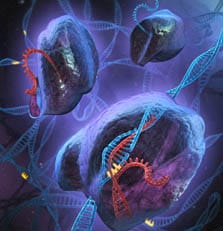New Technique Boosts Researchers’ Ability to Edit Genomes

Researchers from the Gladstone Institute of Cardiovascular Disease and the University of California in San Francisco have recently found a quicker way to boost the introduction and/or identification of rare mutations in the human genome without compromising its integrity.
Bruce Conklin and coworkers describe their findings in Nature Methods. The new technique allows induction or reverse disease-related mutations in induced pluripotent stem cells (iPS) without the need to use antibiotic resistance markers. The previous method left scars in the genome that can alter the resulting phenotype and lead to wrong conclusions. “In many cases, antibiotic maker genes left in the genome affect expression of genes around them in mice. This is a pretty well established concept, and why people remove the markers by Cre or Flippase (…) we really do not know exactly how the genomic DNA sequences function. For example, splicing is regulated by multiple DNA elements. If we hit regulatory elements of splicing, they will definitely affect gene expression”, explained Dr. Miyaoka, postdoctoral fellow of the Gladstone Institute and the paper’s first author.
This marker-free approach already existed but the identification of recombinant iPS cells relied on extensive isolation and characterization of clones. “When I started this project in February 2012, I simply wanted to introduce point mutations associated with human disease. However, there was no easy method to do that (…) I felt it was almost impossible to introduce point mutations with the existing methods at that time”, said Dr. Miyaoka. The new technique using ddPCR reduces the work time to obtain a tenfold amplified mutant, while also reducing costs associated with processing multiple cell lines at the same time.
The authors first introduced point mutations in specific sites by inducing a double strand break with complementary RNA-guided nucleases, to which cells respond with homologous recombination. A DNA oligonucleotide with the desired mutation was then introduced and recombination happened at a rate below 1%. Next, they combined the droplet digital PCR (ddPCR) and TaqMan PCR techniques. ddPCR allows to fractionate a PCR sample to obtain multiple independent amplifications instead of one. The desired mutation site was amplified with primers designed to avoid the fruitless pursuit of off-target recombinants. TaqMan fluorescent probes that could bind either the mutant or the wild type allele were added to the reaction, so that the ddPCR allowed identifying the mutant-enriched fractions. These fractions were further subdivided until a recombinant was isolated.
This new technique is predicted to have a strong impact in the advancement of research in genetic diseases in iPS cells. “Many labs are working on human disease modeling, and the majority of human mutations are point mutations. Therefore, our method should have a wide impact. The only special equipment needed here is ddPCR. Otherwise, it is easy to implement”, added Dr. Miyaoka, who also thinks the “scarless” genome editing is critical especially for future therapeutic purposes, “because we do not know what artificial DNA elements do in the cells”.

